Tunable Luminescence of Sm3+/Tb3+ Co-Doped CaMoO4 Phosphors Synthesized by Microwave-Assisted Heating
Abstract
:1. Introduction
2. Materials and Methods
3. Results
4. Conclusions
Author Contributions
Funding
Conflicts of Interest
References
- Yu, H.; Li, Z.; Lee, A.J.; Li, J.; Zhang, H.; Wang, J.; Pask, H.; Piper, J.; Jiang, M. A continuous wave SrMoO_4 Raman laser. Opt. Lett. 2011, 36, 579–581. [Google Scholar] [CrossRef] [PubMed]
- Jiang, H.; Rooh, G.; Kim, H.J.; Park, H.; So, J.H.; Kim, S.; Kim, Y.D.; Zhang, W. Growth and scintillation characterizations of SrMoO4 single crystals. J. Korean Phys. Soc. 2013, 63, 2018–2023. [Google Scholar] [CrossRef]
- Pandey, I.R.; Kim, H.; Kim, Y. Growth and characterization of Na2Mo2O7 crystal scintillators for rare event searches. J. Cryst. Growth 2017, 480, 62–66. [Google Scholar] [CrossRef]
- Ahmed, N.; Kraus, H.; Kim, H.J.; Mokina, V.; Tsiumra, V.; Wagner, A.; Zhydachevskyy, Y.; Mykhaylyk, V.B. Characterisation of tungstate and molybdate crystals ABO4 (A = Ca, Sr, Zn, Cd; B = W, Mo) for luminescence lifetime cryothermometry. Materialia 2018, 4, 287–296. [Google Scholar] [CrossRef]
- Kaur, P.; Kumar, R.; Davessar, S.; Khanna, A. Structural and optical characterization of Er-doped CaMoO4 down-converting phosphors. Acta Crystallogr. Sect. B Struct. Sci. Cryst. Eng. Mater. 2020, B76, 926–938. [Google Scholar] [CrossRef]
- Singh, M.; Haq, W.U.; Bishnoi, S.; Singh, B.P.; Arya, S.; Khosla, A.; Gupta, V. Investigating photolumi-nescence properties of Eu3+ doped CaWO4 nanoparticles via Bi3+ amalgamation for w-LEDs application. Mater. Technol. 2021, 39, 1051–1061. [Google Scholar]
- Cao, C.; Yang, X.; Chen, X.; Xie, A. Enhanced emission of Eu3+ in lutetium tungsten molybdenum oxide phosphors: Synthesis, optical properties, thermal behavior, and LED packaging. J. Lumin. 2020, 223, 117269. [Google Scholar] [CrossRef]
- Cavalli, E.; Boutinaud, P.; Mahiou, R.; Bettinelli, M.; Dorenbos, P. Luminescence Dynamics in Tb3+-Doped CaWO4 and CaMoO4 Crystals. Inorg. Chem. 2010, 49, 4916–4921. [Google Scholar] [CrossRef]
- Zhai, Y.; Han, Y.; Zhao, X.; Yang, S.; Liu, H.; Song, P.; Jia, G. Microwave synthesis of CaMoO4:Sm3+ orange reddish-emitting phosphors and its photoluminescence property. J. Mater. Sci. Mater. Electron. 2017, 28, 15208–15216. [Google Scholar] [CrossRef]
- Thongtem, T.; Kungwankunakorn, S.; Kuntalue, B.; Phuruangrat, A.; Thongtem, S. Luminescence and absorbance of highly crystalline CaMoO4, SrMoO4, CaWO4 and SrWO4 nanoparticles synthe-sized by co-precipitation method at room temperature. J. Alloy. Compd. 2010, 506, 475–481. [Google Scholar] [CrossRef]
- Karki, S.; Aryal, P.; Ha, D.; Kim, H.J.; Park, H.K.; Pandey, I.R. Synthesis, Luminescence and Optical Properties of a CaMoO4 Nano-Powder Prepared by Using the Precipitation Method. J. Korean Phys. Soc. 2019, 75, 534–540. [Google Scholar] [CrossRef]
- Liao, J.; Qiu, B.; Wen, H.; Chen, J.; You, W.; Liu, L. Synthesis process and luminescence properties of Tm3+ in AWO4 (A = Ca, Sr, Ba) blue phosphors. J. Alloys Compd. 2009, 487, 758–762. [Google Scholar] [CrossRef]
- Sczancoski, J.C.; Bomio, M.D.R.; Cavalcante, L.S.; Joya, M.R.; Pizani, P.S.; Varela, J.A.; Longo, E.; Li, M.S.; Andrés, J.A. Morphology and Blue Photoluminescence Emission of PbMoO4 Processed in Conventional Hydrothermal. J. Phys. Chem. C 2009, 113, 5812–5822. [Google Scholar] [CrossRef]
- Xu, C.; Zou, D.; Guo, H.; Jie, F.; Ying, T. Luminescence properties of hierarchical CaMoO4 micro-spheres derived by ionic liquid-assisted process. J. Lumin. 2009, 129, 474–477. [Google Scholar] [CrossRef]
- Wu, H.; Hu, Y.; Zhang, W.; Kang, F.; Li, N.; Ju, G. Sol–gel synthesis of Eu3+ incorporated CaMoO4: The enhanced luminescence performance. J. Sol-Gel Sci. Technol. 2012, 62, 227–233. [Google Scholar] [CrossRef]
- Xu, M.; Si, J.; Li, G.; Liu, Y.; Cai, G.; Zhang, J. Structure, tunable luminescence and thermal stability in Tb3+ and Eu3+ co-doped novel KBaIn2(PO4)3 phosphors. J. Lumin. 2020, 221, 117115. [Google Scholar] [CrossRef]
- Tranquilin, R.L.; Lovisa, L.X.; Almeida, C.R.R.; Paskocimas, C.A.; Li, M.S.; Oliveira, M.C.; Gracia, L.; Andres, J.; Longo, E.; Motta, F.V.; et al. Understanding the white-emitting CaMoO4 co-doped Eu3+, Tb3+, and Tm3+ phosphor through experiment and computation. J. Phys. Chem. C 2019, 123, 18536–18550. [Google Scholar] [CrossRef]
- Kuzmanoski, A.; Pankratov, V.; Feldmann, C. Microwave-assisted ionic-liquid-based synthesis of highly crystalline CaMoO4:RE3+ (RE = Tb, Sm, Eu) and Y2Mo4O15:Eu3+ nanoparticles. Solid State Sci. 2015, 41, 56–62. [Google Scholar] [CrossRef]
- Shih, H.-R.; Chang, Y.-S. Structure and Photoluminescence Properties of Sm3+ Ion-Doped YInGe2O7 Phosphor. Materials 2017, 10, 779. [Google Scholar] [CrossRef] [Green Version]
- Liu, Z.; Sun, X.; Xu, S.; Lian, J.; Li, X.; Xiu, Z.; Li, Q.; Di Huo, A.; Li, J.-G. Tb3+- and Eu3+-Doped Lanthanum Oxysulfide Nanocrystals. Gelatin-Templated Synthesis and Luminescence Properties. J. Phys. Chem. C 2008, 112, 2353–2358. [Google Scholar] [CrossRef]
- Kaur, S.; Rao, A.; Jayasimhadri, M.; Jaiswal, V.V.; Haranath, D. Tb3+ ion induced colour tunability in calcium aluminozincate phosphor for lighting and display devices. J. Alloys Compd. 2020, 826, 154212. [Google Scholar] [CrossRef]
- Ansari, A.A.; Alam, M. Optical and structural studies of CaMoO4:Sm, CaMoO4:Sm@CaMoO4 and CaMoO4:Sm@CaMoO4@SiO2 core–shell nanoparticles. J. Lumin. 2015, 157, 257–263. [Google Scholar] [CrossRef]
- Ren, Q.; Zhao, Y.; Wu, X.; Hai, O. The color tunable of Tb3+/Sm3+ co-doped phosphors through Tb3+ → Sm3+ energy transfer. Polyhedron 2020, 192, 114862. [Google Scholar] [CrossRef]
- Dixit, P.; Chauhan, V.; Kumar, P.; Pandey, P.C. Enhanced photoluminescence in CaMoO4:Eu3+ by Mn2+ co-doping. J. Lumin. 2020, 223, 117240. [Google Scholar] [CrossRef]
- Song, S.; Si, J.; Zhang, J.; Cai, G. Structure, tunable luminescence and energy transfer in Tb3+ and Eu3+ co-doped Ba3InB9O18 phosphors. RSC Adv. 2019, 9, 1029–1035. [Google Scholar] [CrossRef] [PubMed] [Green Version]
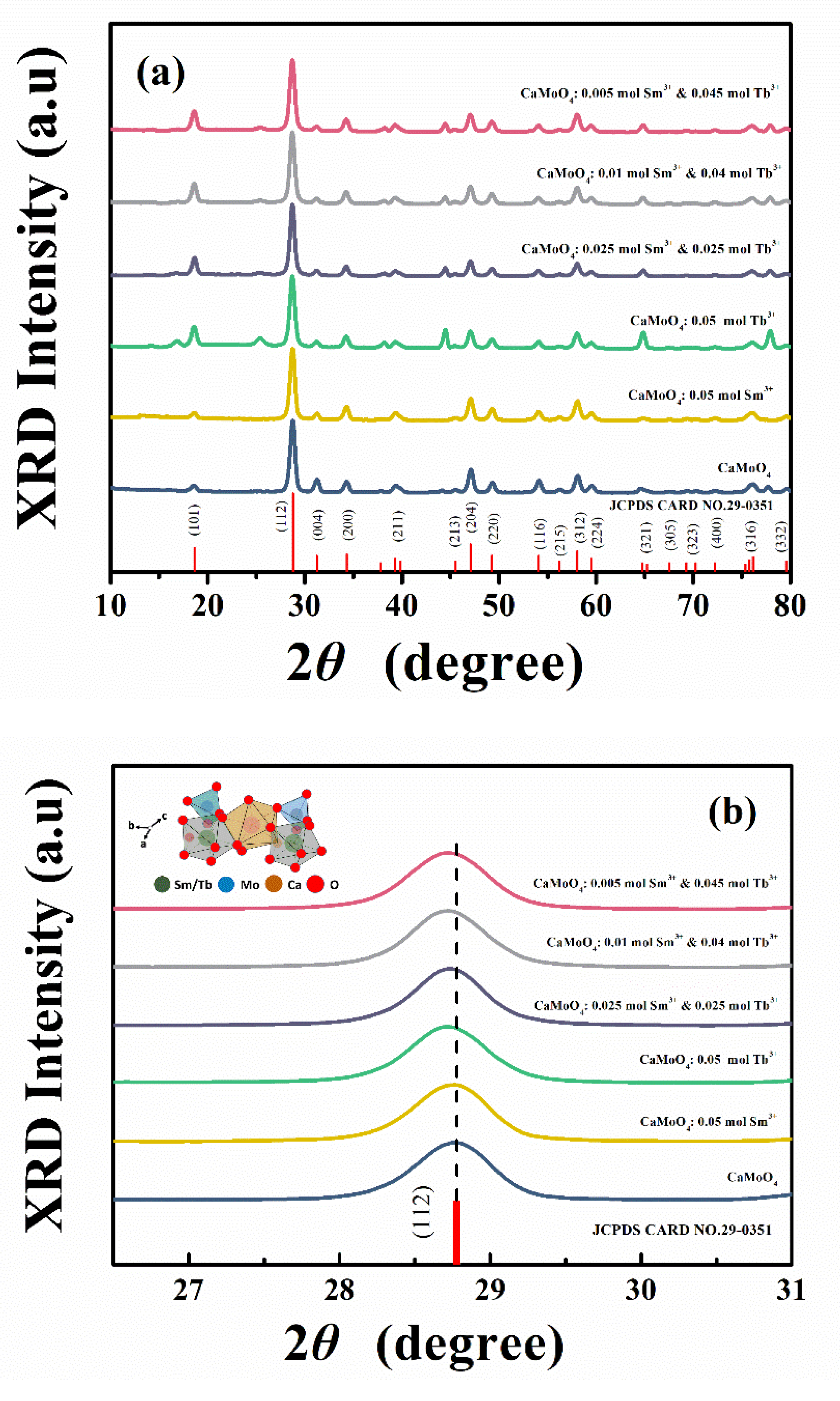
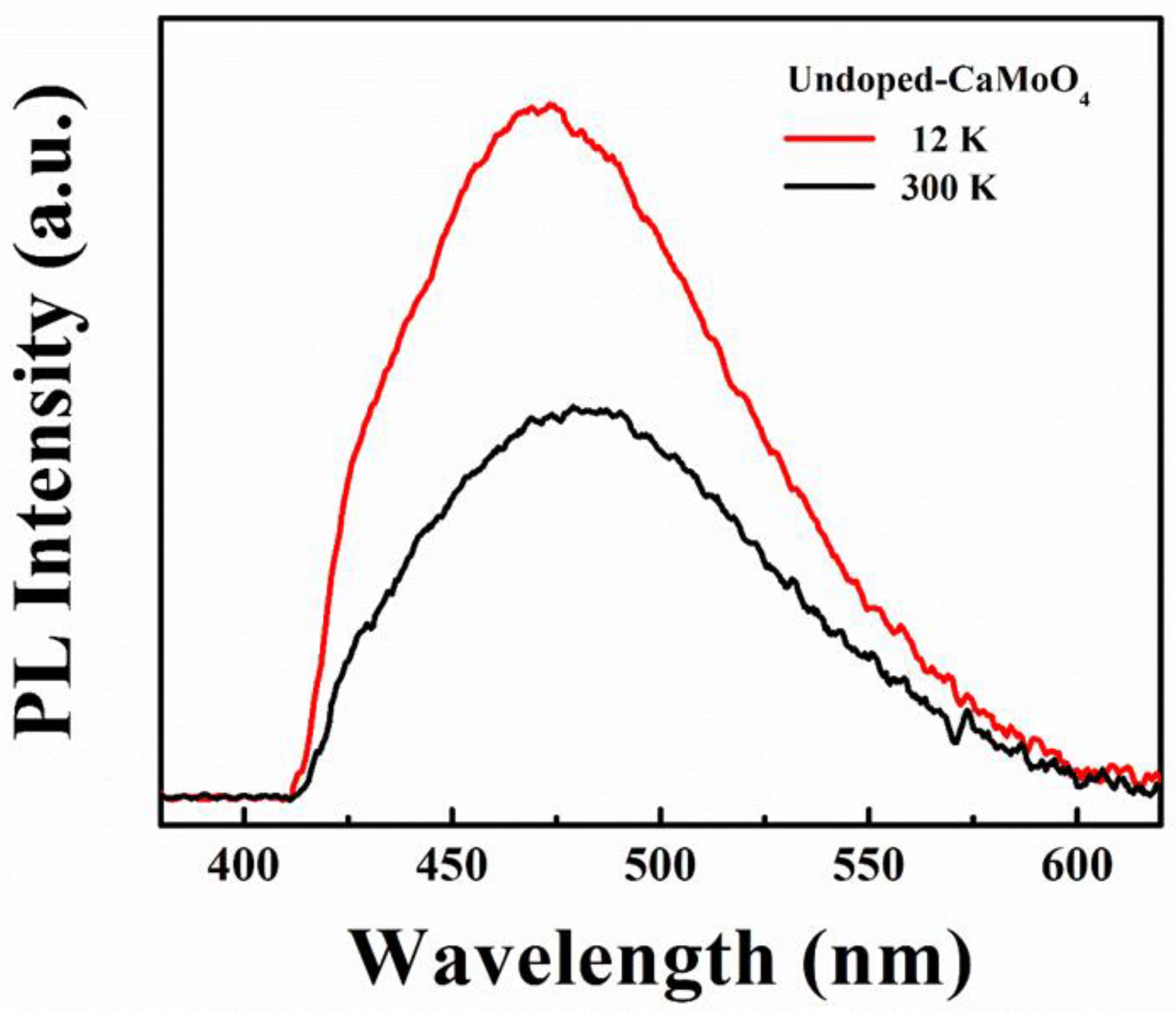
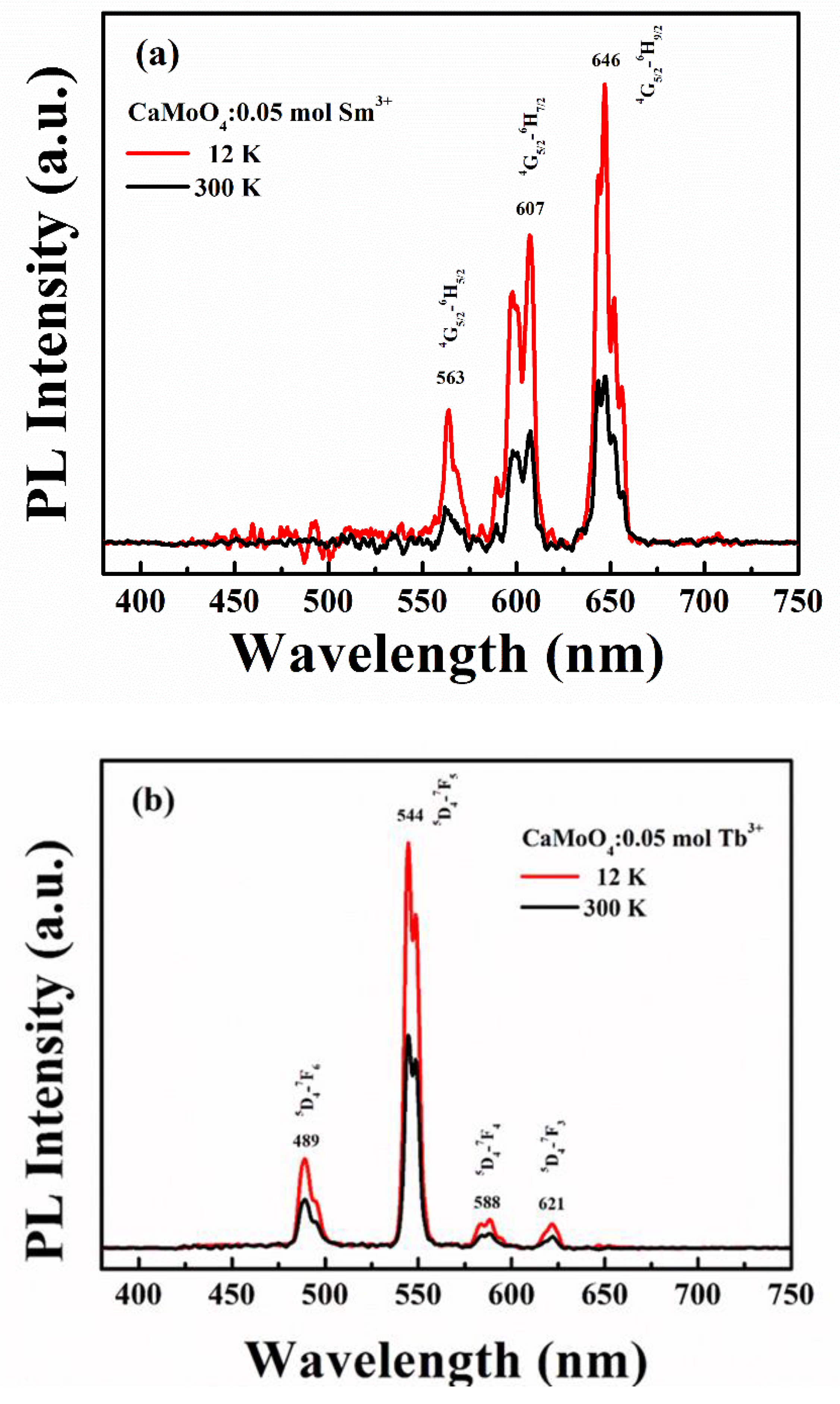
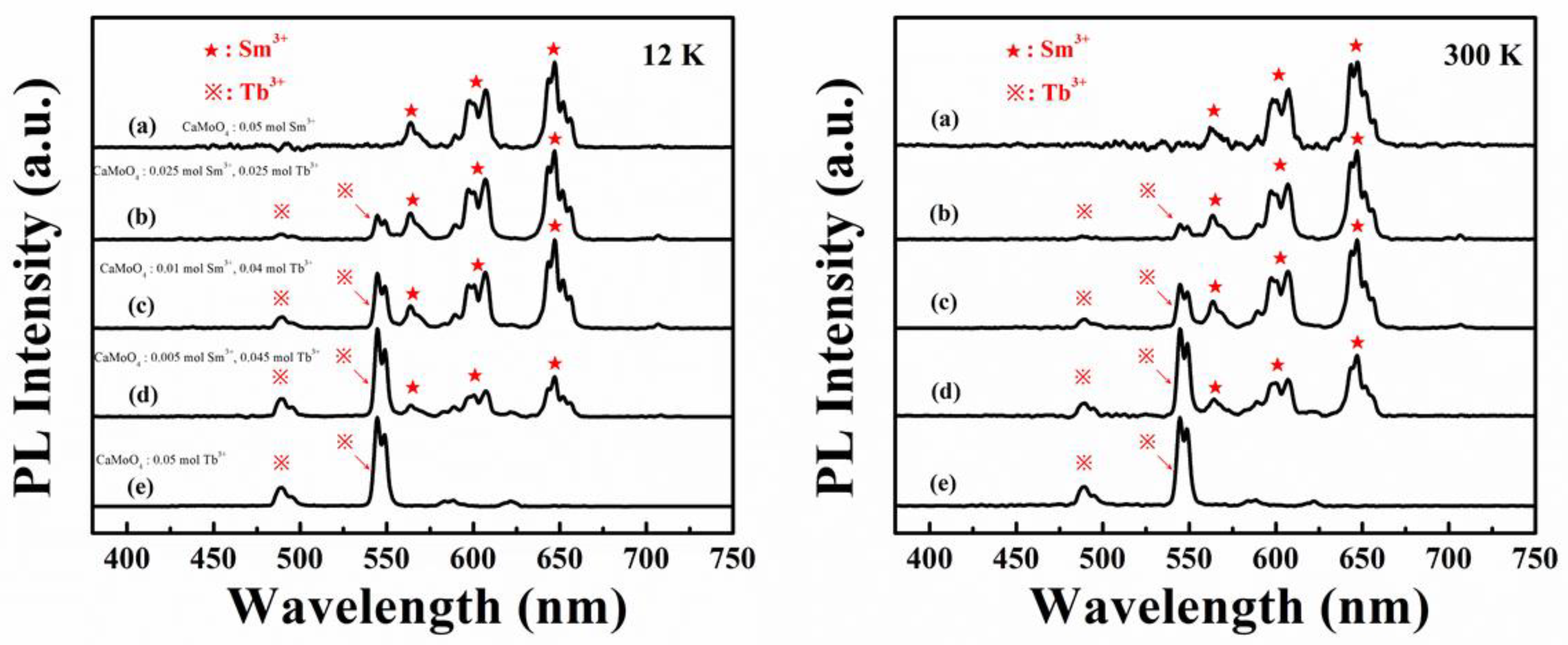
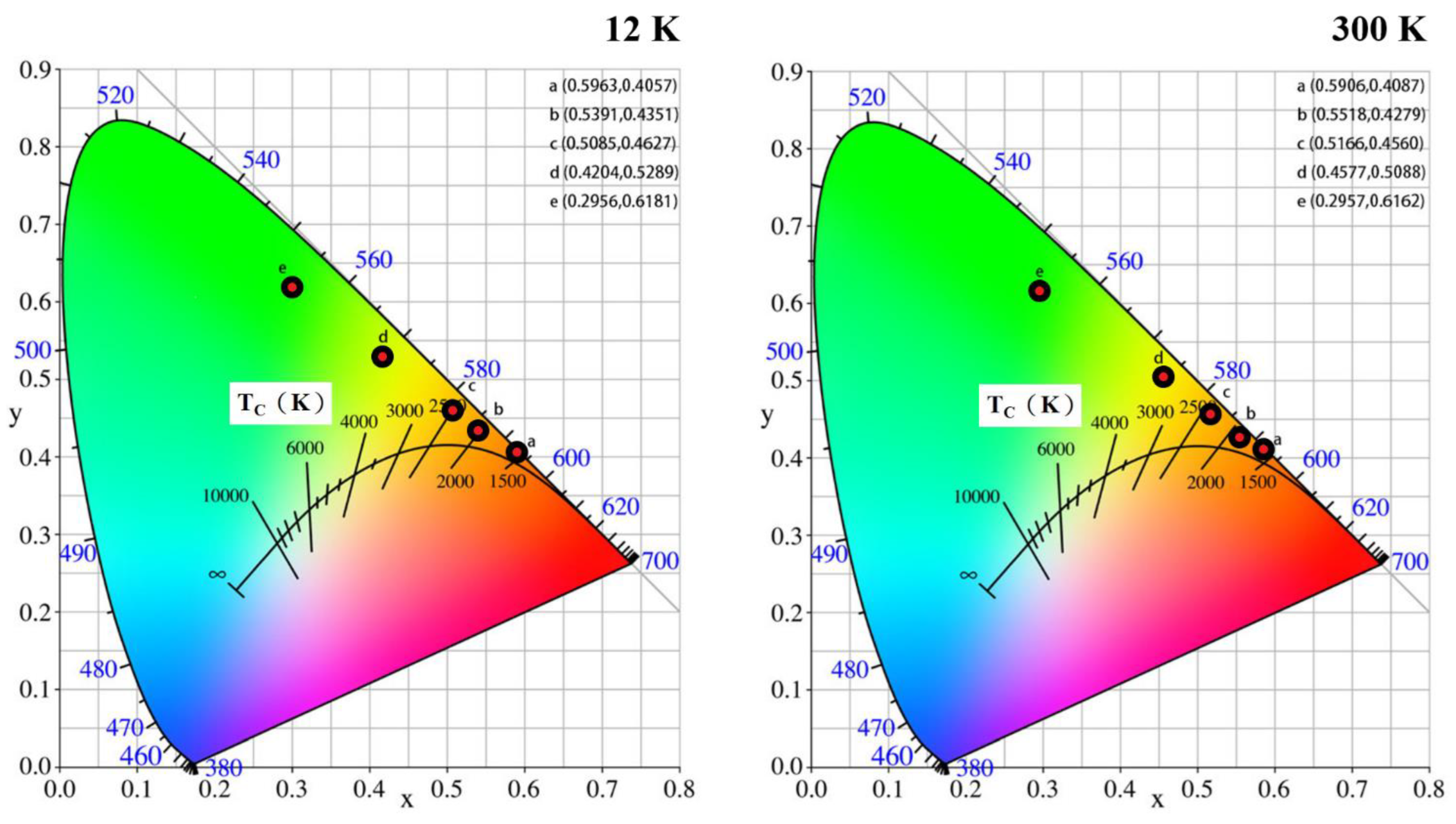
Publisher’s Note: MDPI stays neutral with regard to jurisdictional claims in published maps and institutional affiliations. |
© 2022 by the authors. Licensee MDPI, Basel, Switzerland. This article is an open access article distributed under the terms and conditions of the Creative Commons Attribution (CC BY) license (https://creativecommons.org/licenses/by/4.0/).
Share and Cite
Wu, W.-T.; Tiong, K.-K.; Lee, Y.-W.; Hu, S.-Y.; Lee, Y.-C.; Huang, W. Tunable Luminescence of Sm3+/Tb3+ Co-Doped CaMoO4 Phosphors Synthesized by Microwave-Assisted Heating. Appl. Sci. 2022, 12, 7883. https://doi.org/10.3390/app12157883
Wu W-T, Tiong K-K, Lee Y-W, Hu S-Y, Lee Y-C, Huang W. Tunable Luminescence of Sm3+/Tb3+ Co-Doped CaMoO4 Phosphors Synthesized by Microwave-Assisted Heating. Applied Sciences. 2022; 12(15):7883. https://doi.org/10.3390/app12157883
Chicago/Turabian StyleWu, Wen-Te, Kwong-Kau Tiong, Yu-Wei Lee, Sheng-Yao Hu, Yueh-Chien Lee, and Wei Huang. 2022. "Tunable Luminescence of Sm3+/Tb3+ Co-Doped CaMoO4 Phosphors Synthesized by Microwave-Assisted Heating" Applied Sciences 12, no. 15: 7883. https://doi.org/10.3390/app12157883
APA StyleWu, W.-T., Tiong, K.-K., Lee, Y.-W., Hu, S.-Y., Lee, Y.-C., & Huang, W. (2022). Tunable Luminescence of Sm3+/Tb3+ Co-Doped CaMoO4 Phosphors Synthesized by Microwave-Assisted Heating. Applied Sciences, 12(15), 7883. https://doi.org/10.3390/app12157883





